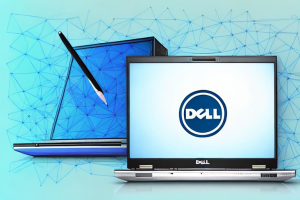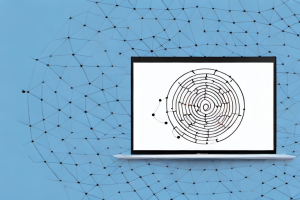How to install Ubuntu on a Dell Precision 7710
8 min read
A laptop with the ubuntu operating system installed
Installing Ubuntu on a Dell Precision 7710 can be a bit tricky, but with the right preparation and knowledge, it can be done with ease. In this article, we will guide you through the entire process of installing Ubuntu on your Dell Precision 7710, from preparing your laptop for installation to ensuring optimal performance afterwards. So, let’s dive right in!
Preparing your Dell Precision 7710 for Ubuntu installation
The first step in installing Ubuntu on your Dell Precision 7710 is to ensure that your laptop meets the minimum system requirements. Your Dell Precision 7710 should have at least 2 GB of RAM and a 25 GB hard drive or more, as well as a DVD drive or USB port. Additionally, it is recommended that you have a fast internet connection for downloading updates and drivers after the installation process.
Next, we recommend backing up any important files or data on your computer to an external hard drive or cloud storage service, as the installation process involves partitioning your hard drive, which could result in data loss if not done properly.
Before proceeding with the installation, it is important to disable any secure boot or fast boot options in your BIOS settings. These options can interfere with the installation process and prevent Ubuntu from booting properly. You can access your BIOS settings by pressing the F2 key during startup.
Once you have disabled these options, you can proceed with creating a bootable USB drive or DVD with the Ubuntu installation files. You can download the latest version of Ubuntu from the official website and use a tool like Rufus or Etcher to create the bootable drive.
Downloading Ubuntu ISO file for Dell Precision 7710
The next step is to download the Ubuntu ISO file from the official website. You will need to select the version of Ubuntu you wish to install, along with the appropriate architecture (32-bit or 64-bit). For Dell Precision 7710, we recommend downloading the 64-bit version for better performance.
It is important to note that the download process may take some time, depending on your internet speed. Once the download is complete, you will need to create a bootable USB drive or DVD using the ISO file. This can be done using software such as Rufus or UNetbootin. Make sure to follow the instructions carefully to ensure that the bootable drive is created correctly.
Creating a bootable USB drive for Ubuntu installation
Once you have downloaded the Ubuntu ISO file, you will need to create a bootable USB drive to install Ubuntu on your Dell Precision 7710. You can use software such as Rufus or Universal USB Installer to create a bootable USB drive. Simply select the ISO file you downloaded and follow the prompts to create the bootable USB drive.
It is important to note that creating a bootable USB drive will erase all data on the USB drive. Therefore, it is recommended to use a blank USB drive or backup any important data before proceeding with the creation of the bootable USB drive. Additionally, make sure to select the correct USB drive when creating the bootable drive to avoid accidentally erasing important data on another drive.
Configuring BIOS settings on the Dell Precision 7710 for Ubuntu installation
Before you can start the installation process, you will need to configure the BIOS settings on your Dell Precision 7710 to boot from the USB drive. To do this, restart your laptop and press the F2 key repeatedly to enter the BIOS settings menu. Once in the menu, navigate to the Boot tab and select the USB drive as the primary boot device. Save your changes and restart your laptop.
It is important to note that some Dell Precision 7710 models may require additional steps to enable booting from a USB drive. If you do not see the USB drive listed as an option in the Boot tab, you may need to enable Legacy Boot Mode or disable Secure Boot in the BIOS settings. Consult your laptop’s user manual or Dell’s support website for specific instructions on how to do this.
Booting from the USB drive to start Ubuntu installation process
Once you have configured the BIOS settings, you can now boot from the USB drive to start the Ubuntu installation process. Simply restart your laptop and press F12 to enter the boot options menu. Select the USB drive and press Enter to boot from it.
It is important to note that the boot options menu may vary depending on the laptop brand and model. Some laptops may require you to press a different key or combination of keys to access the boot options menu. It is recommended to check the laptop’s manual or manufacturer’s website for specific instructions on how to access the boot options menu.
Selecting language and time zone settings during Ubuntu installation
After booting from the USB drive, you will be presented with the Ubuntu installation screen. Select your preferred language and time zone settings and click the Install Ubuntu button to continue.
Choosing the correct language and time zone settings during Ubuntu installation is crucial for ensuring that your system operates smoothly and accurately. The language setting determines the language in which your system will display menus, messages, and other text. The time zone setting, on the other hand, determines the time zone in which your system will operate, which is important for accurate timekeeping and scheduling tasks.
It is important to note that you can change these settings later on, but doing so may require additional configuration and may cause some applications to behave unexpectedly. Therefore, it is recommended that you choose the correct language and time zone settings during installation to avoid any potential issues down the line.
Partitioning the hard drive for Ubuntu installation on Dell Precision 7710
Next, you will need to partition your hard drive to install Ubuntu alongside your existing operating system, or to replace it entirely. You can choose to either use the guided partitioning tool or manually partition your hard drive to allocate space for Ubuntu.
If you choose to use the guided partitioning tool, Ubuntu will automatically allocate space for the operating system and create a swap partition. However, if you prefer to manually partition your hard drive, you will need to allocate space for the root partition, home partition, and swap partition.
It is important to note that when partitioning your hard drive, you should always back up your important data to avoid any potential loss. Additionally, if you are installing Ubuntu alongside an existing operating system, make sure to choose the correct partition to avoid overwriting important data.
Installing Ubuntu on Dell Precision 7710 using the graphical installer
Once you have partitioned your hard drive, you can start the installation process. Simply follow the prompts in the graphical installer to complete the installation process, including selecting your username and password, and customizing software installation options.
It is important to note that during the installation process, you may encounter errors or issues. If this happens, you can refer to the Ubuntu documentation or seek help from the Ubuntu community forums. Additionally, it is recommended to backup your important files before proceeding with the installation to avoid any data loss.
After the installation is complete, you can start exploring the features and functionalities of Ubuntu. You can customize the desktop environment, install additional software packages, and configure system settings according to your preferences. Ubuntu also provides regular updates and security patches, ensuring a stable and secure operating system for your Dell Precision 7710.
Installing Ubuntu on Dell Precision 7710 using the command-line installer (alternate method)
If you prefer, you can also install Ubuntu on your Dell Precision 7710 using the command-line installer. This method involves using the Terminal to complete the installation process, and is recommended for advanced users who are comfortable with the command line interface.
One advantage of using the command-line installer is that it allows for more customization during the installation process. You can choose which packages to install, and configure the system to your specific needs. However, it is important to note that this method requires more technical knowledge and can be more time-consuming than the graphical installer.
Configuring network settings in Ubuntu after installation on Dell Precision 7710
After installing Ubuntu, you may need to configure your network settings to connect to the internet. You can do this by navigating to the System Settings menu and selecting the Network option. From there, follow the prompts to connect to your preferred network.
If you are having trouble connecting to a wireless network, you may need to install additional drivers for your wireless card. To do this, you can open the Additional Drivers tab in the Software & Updates menu and select the appropriate driver for your hardware. Once installed, you should be able to connect to wireless networks without any issues.
Installing necessary drivers and updates after installing Ubuntu on Dell Precision 7710
Once you have connected to the internet, it is recommended that you install any necessary drivers and updates for your Dell Precision 7710. You can do this by navigating to the Software & Updates menu and selecting the Additional Drivers tab to install any necessary drivers. To install updates, navigate to the Updates tab and click the Check button to search for updates.
It is important to note that installing the necessary drivers and updates can improve the performance and stability of your Dell Precision 7710. Failure to install these updates may result in compatibility issues with certain software or hardware components. Additionally, it is recommended that you regularly check for updates and install them as they become available to ensure that your system is up-to-date and secure.
Troubleshooting common issues during Ubuntu installation on Dell Precision 7710
If you encounter any issues during the Ubuntu installation process on your Dell Precision 7710, there are a few common troubleshooting steps you can take. These include checking your BIOS settings, verifying your USB drive, and ensuring that your laptop meets the minimum system requirements.
Another common issue that may arise during Ubuntu installation on Dell Precision 7710 is the graphics driver. If you experience any display issues, such as flickering or distorted images, it may be due to an incompatible or outdated graphics driver. To resolve this, you can try updating the graphics driver through the Ubuntu Software Center or by downloading the latest driver from the Dell website.
Tips and tricks for optimizing performance of Ubuntu on Dell Precision 7710
Finally, to optimize the performance of Ubuntu on your Dell Precision 7710, we recommend disabling any unnecessary background processes and services, using the Unity Tweak Tool to customize the desktop environment, and updating your software regularly to ensure you have the latest security patches and bug fixes.
And there you have it – a complete guide to installing Ubuntu on your Dell Precision 7710. With these steps and tips, you should be up and running with Ubuntu in no time. Happy installing!
Another tip for optimizing performance on your Dell Precision 7710 is to upgrade your hardware, such as adding more RAM or a solid-state drive. This can significantly improve the speed and responsiveness of your system.
Additionally, you can try using lightweight applications and avoiding resource-intensive programs to reduce the strain on your system. This can help improve overall performance and prevent crashes or freezes.


